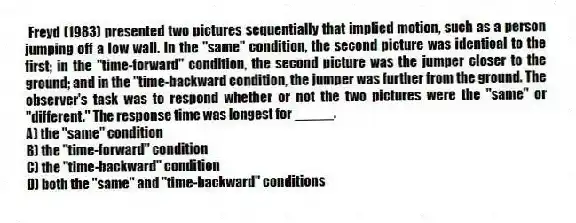
Freyd (1983) presented two pictures sequentially that implied motion, such as a person jumping off a low wall. In the "same" condition, the second picture was identical to the first; in the "time-forward" condition, the second picture was the jumper closer to the ground; and in the "time-backward condition, the jumper was further from the ground. The observer's task was to respond whether or not the two pictures were the "same" or "different." The response time was longest for _____.
A) the "same" condition
B) the "time-forward" condition
C) the "time-backward" condition
D) both the "same" and "time-backward" conditions
Correct Answer:
Verified
Q34: A "point-light walker" wears lights on different
Q35: Which of the following stimuli is most
Q36: In an apparent motion demonstration, two pictures
Q37: Pack and Born (2001) found that the
Q38: _ is a technique that has been
Q40: In one study, Zacks et al. (2009)
Q41: What does Gibson mean by the "optic
Q42: Describe Francesca Simion's work with biological motion
Q43: Review the evidence for the physiological basis
Q44: What is the aperture problem
How does the
Unlock this Answer For Free Now!
View this answer and more for free by performing one of the following actions

Scan the QR code to install the App and get 2 free unlocks

Unlock quizzes for free by uploading documents